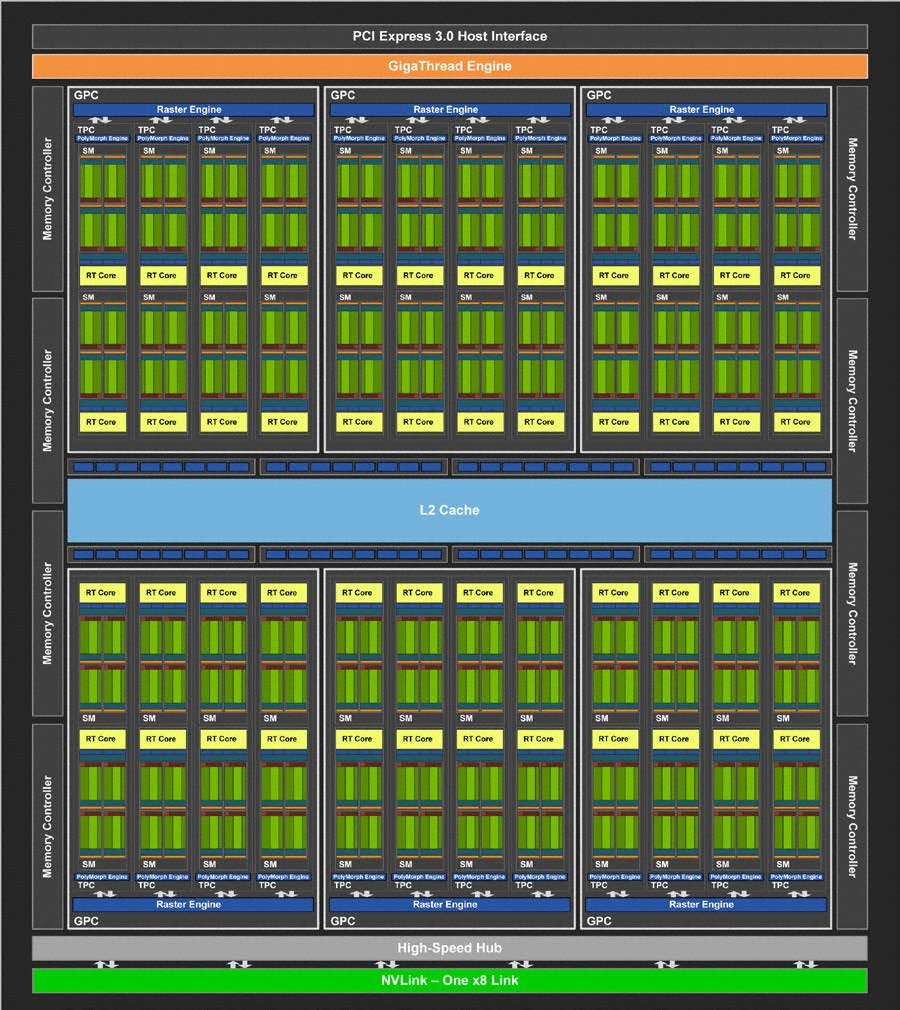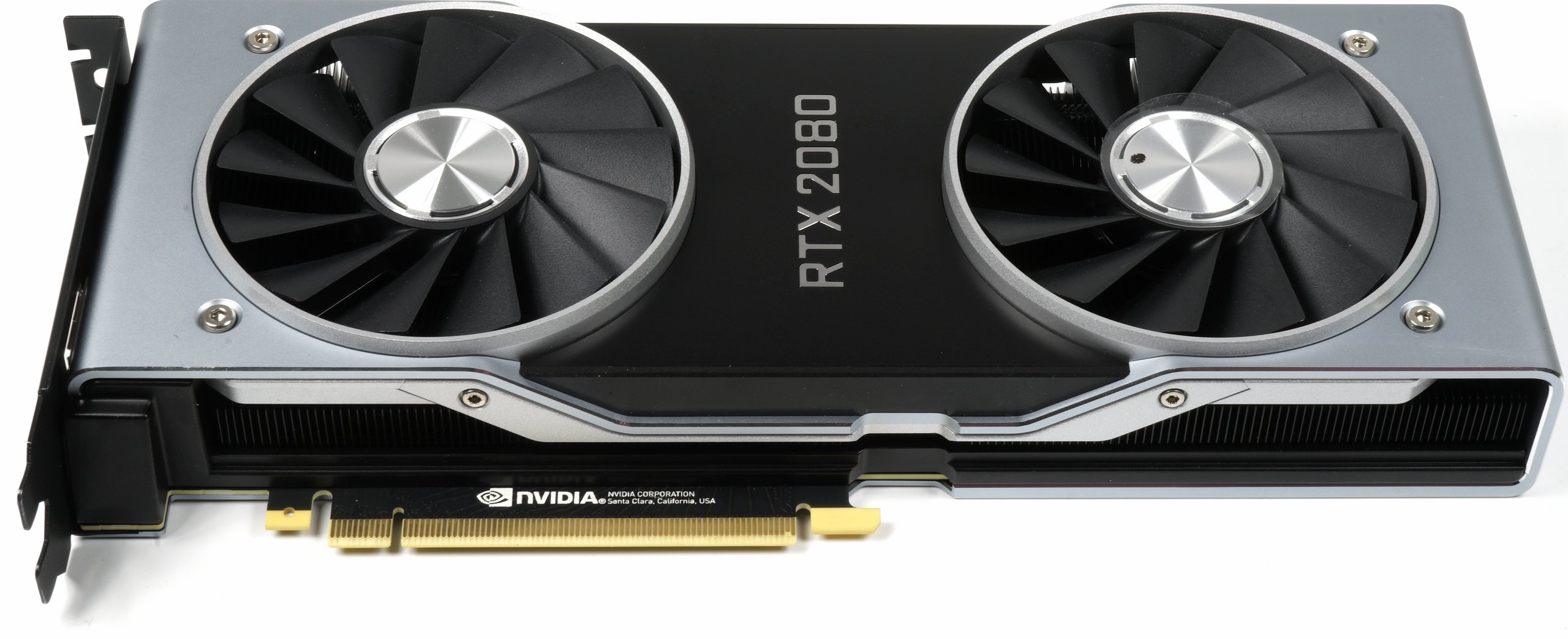TU104: Turing offshoot for the middle class
It is not the case that TU104 could become an unloved child, probably on the contrary. But it is already new that Nvidia is introducing different performance classes for the different salary classes at the same time. On the other hand, compared to a GeForce RTX 2080 Ti from approx. 1200 Euro, the GeForce RTX 2080 with around 850 Euros is a slightly more realistic option, even for the toughest gamblers.
Similar to the TU102, TSMC manufactures the TU104 on its 12nm FinFET node. But a transistor number of 13.6 billion leads to a smaller, "only" 545 mm2 Die area. Of course, this also saves costs in the end. However, Turing Junior still surpasses the 471 mm2 of the GP102 as the flagship of the last generation and comes quite close to the size of the GK110 in the original GeForce GTX Titan.
The TU104 is made up of the same building blocks as the TU102; but there is only a little less of everything. The streaming multiprocessors still have 64 CUDA cores, eight tensor cores, one RT core, four texture units, 16 load/storage units, 256KB register memory, and 96KB L1 cache/shared memory. The TPCs also still consist of two SMs and a PolyMorph geometry engine. But there are now only four TPCs per GPC and the six GPCs are distributed across the processor. Therefore, a fully functional TU104 has a total of 48 SMs, 3072 CUDA cores, 384 tensor cores, 48 RT cores, 192 texture units and 24 PolyMorph engines.
A correspondingly narrower back-end implements the connection via eight 32-bit GDDR6 memory controllers (256-bit aggregate) connected to 64 ROPs and 4 MB L2 cache. The TU104 also loses one of the TU102's two x8 NVLink connections, which then limits the whole thing to one x8 connection and 50 GB/s bidirectional throughput.
GeForce RTX 2080: TU104 gets a light shorthair cut
After seeing in the presentations that the "old" GeForce RTX 2080 Ti in Battlefield V at 1920×1080 with ray tracing enabled still delivers a quite respectable performance, we can't help but wonder if GeForce RTX 2080 will be fast enough to playable frame rates. Even a complete TU104 GPU is limited to 48 RT cores instead of 64 RT compared to the TU102. But now that Nvidia is using the laser cut and turning off one of the TU104's TPCs for the GeForce RTX 2080, another pair of RT cores will be lost (along with 128 CUDA cores, eight texture units, 16 tensor cores, etc.).
In the end, the GeForce RTX 2080 has 46 SMs that contain 2944 CUDA cores, 368 tensor cores, 46 RT cores, 184 texture units, 64 ROPS, and 4 MB l2 cache. Eight gigabytes of 14Gb/s GDDR6 on a 256-bit bus move up to 448GB/s of data, resulting in more than 100GB/s of storage bandwidth that also goes far beyond what the GeForce GTX 1080 can do.
The maps of the reference and the Founders Edition each have a base clock of 1515 MHz. Nvidia's own overclocked models come with a GPU boost of 1800 MHz, while the reference specification is only 1710 MHz. The top performance of 10.6 TFLOPS pushes the GeForce RTX 2080 Founders Edition behind the GeForce GTX 1080 Ti (11.3 TFLOPS), but it is still well ahead of the GeForce GTX 1080 (8.9 TFLOPS). Of course, the faster Founders Edition model also takes on more performance. Its 225W TBP is 10W higher than the reference GeForce RTX 2080 and 45W higher than that of the last generation GeForce GTX 1080.
- 1 - Einführung und Vorstellung
- 2 - TU102 + GeForce RTX 2080 Ti
- 3 - TU104 + GeForce RTX 2080
- 4 - TU106 + GeForce RTX 2070
- 5 - Performance-Anstieg für bestehende Anwendungen
- 6 - Tensor-Kerne und DLSS
- 7 - Ray Tracing in Echtzeit
- 8 - NVLink: als Brücke wohin?
- 9 - RTX-OPs: wir rechnen nach
- 10 - Shading-Verbesserungen
- 11 - Anschlüsse und Video
- 12 - 1-Klick-Übertaktung
- 13 - Tschüss, Gebläselüfter!
- 14 - Zusammenfassung und Fazit




































Kommentieren